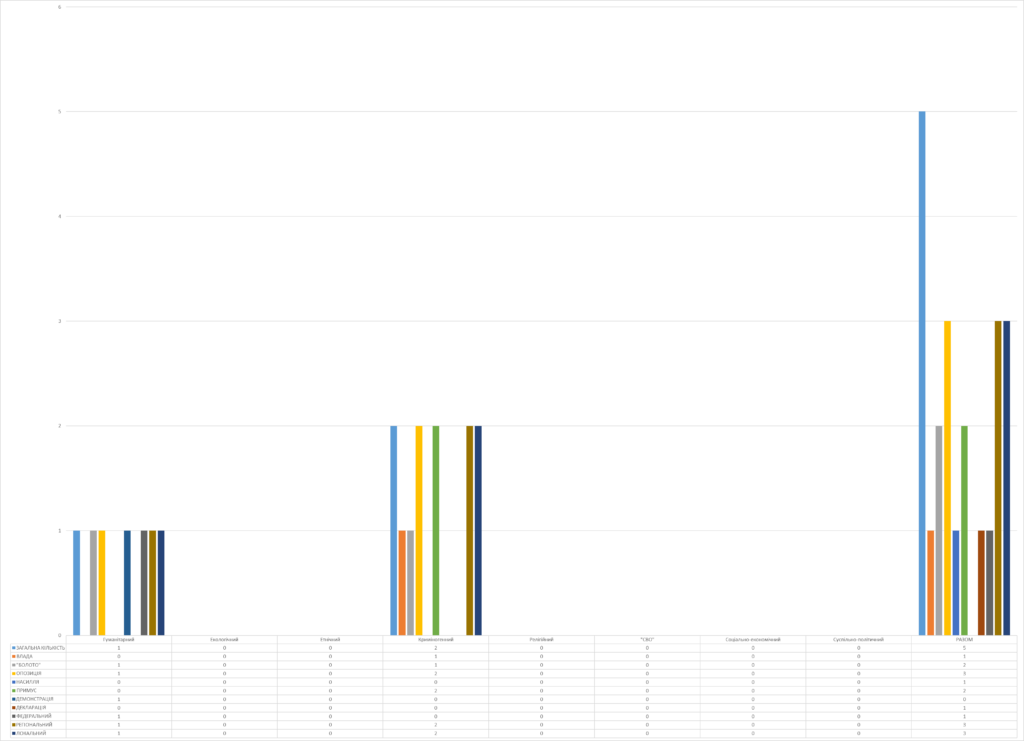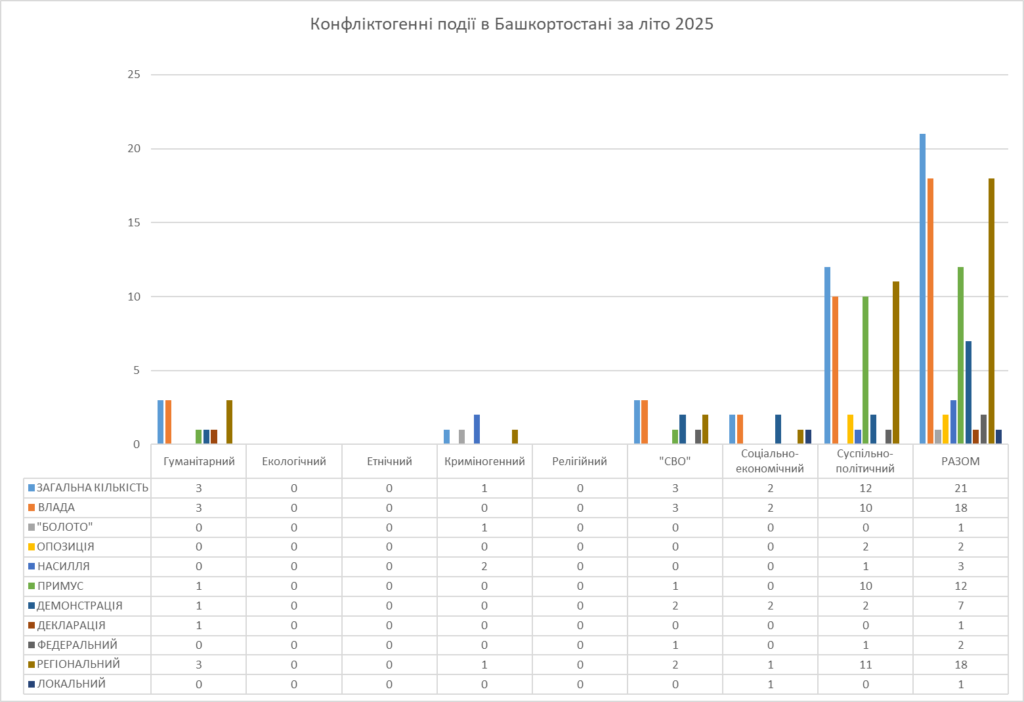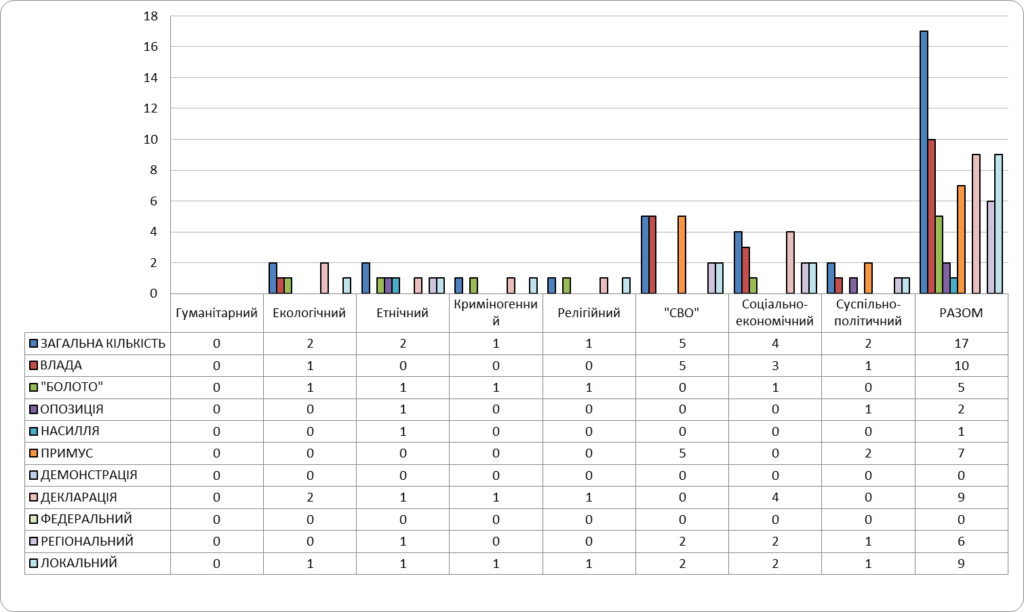The non-governmental analytical center “Ukrainian Strategic Studies” is continuing its long-term project of Monitoring Regional Processes in the Russian Federation.
The research goal is to record and to determine the dynamics of conflict-generating and disintegration factors that will contribute to the deconstruction of the Russian Federation and its disappearance as a geopolitical reality.
The object of the monitoring is the information field of the Russian Federation. The most popular news stories from various regions of Russia for the quarter are analyzed, which will provide more or-less clear understanding of the internal processes within the aggressor state and monitoring of conflict-generating regional processes.
Monitoring of Regional Processes in the RF: Summer 2025
During the summer period, the struggle for power in the Russian regions intensified, which is evidently a consequence of economic problems – the “feeding trough” is shrinking and there is no longer enough for everyone. The geography of Ukrainian UAV arrivals is expanding. Now the war is knocking on the doors of not only the regions bordering Ukraine. A factor relevant to all regions of Russia is the worsening socio-economic situation.
CENTRAL-WESTERN REGION
Muscovy
The situation in the region is relatively stable economically, but the humanitarian sphere is under pressure. The summer period was marked by the arrests of the scientists, internet shutdowns, restrictions on the information space, and the promotion of “traditional values.”
Military factor: Attacks by the Armed Forces of Ukraine on strategic objects have led to a repression wave and a “witch hunt.” The socio-political background was marked by the adoption of the repressive laws (on the “search for extremist materials”), increased pressure on the media, and rising complaints from the political prisoners about the tortures.
Isolated pickets and conflicts are emerging between the authorities, the Communist Party of the Russian Federation (CPRF), and the far-right, which could result in the liquidation of these structures. At the same time, the environmental factor has become the most dangerous. Eco-protests in the Moscow region have become spontaneous and massive, as they unite people of the different political views and don’t have the direct opposition basis. This makes them the most potentially radicalized movement.
The main conflict-generating factors are the humanitarian restrictions and the environment. Worsening of the socio-economic situation and an intensification of protests will be possible on autumn.
July

August

Bryansk Oblast
The Bryansk Oblast suffered by the serious humanitarian and military blows. The tragedy of June 1st—the collapse of a bridge in Vygonichi with 7 deaths as result caused a public outcry. The authorities traditionally blamed a “Ukrainian sabotage and reconnaissance group (DRG).” At the same time, the region faced daily massive UAV attacks (10–12 per day), leading to civilian and military casualties. The largest attacks occurred in June-July (up to 48 UAVs simultaneously).
The socio-political situation was aggravated by corruption scandals: the vice-governor was sent to a pre-trial detention center for a bribe of 818 million rubles, and a deputy was caught in a scheme to purchase “combat veteran” status. Demographic and religious factors also sparked debate ranging from ideas to restrict internet access for childless couples to initiatives to “purify” the Russian language. The war brought significant losses: over 500 military personnel during the summer. Social tension was growing, and the inadequate initiatives of the authorities only added fuel to the fire.
This summer, the Bryansk Oblast became a region with a high level of military and social turmoil, where the population was gradually losing trust in the government.
| Категорія | Червень | Липень | Серпень |
| Гуманітарний | -2 | 0 | 1 |
| Екологічний | -0.5 | -1 | 0 |
| Національний | -0.5 | -1 | -0.25 |
| Релігійний | 0 | 1.5 | 0.5 |
| «СВО» | -1 | -1.2 | -0.5 |
| Суспільно — політичний | -1.2 | -1.5 | -0.5 |
CAUCASUS
Dagestan
Dagestan experienced a series of high-profile events. In June, the FSB conducted large-scale searches related to the former Secretary of State Magomedov, and cases of torture were recorded at the Center for Countering Extremism. In July, a massive power outage left over 86,000 residents without electricity. Simultaneously, news broke of mass E. coli poisoning that affected more than 400 people (mostly children). Court proceedings for the riots at Makhachkala airport happened and over 130 people sentenced in result. The mobilization situation remained alarming: some teenagers after being tortured were forced to sign contracts and sent to the front. August brought new incidents of tourist poisonings and protests in Makhachkala over power outages. Repressions against local officials and activists were intensifying, including cases against human rights activist Svetlana Anokhina and the nationalization of the large assets belonging to the ex-officials.
Overall, the region demonstrated the increase in repression and the growth of the grassroots protests on a backdrop of the infrastructure collapses and the military pressure.

North-Western Caucasus
From June to August 2025, the situation in the North-Western Caucasus was characterized by instability and increased tension between the population and the federal government. The region is marked by the complex set of problems: political persecution, pressure on local activists, and the exacerbation of the religious and the national issues. Russian repressive agencies paid the special attention to control the information space by blocking channels, pressuring religious leaders, and persecuting critics. The economic situation remained difficult with the high levels of the unemployment and the migration, the social inequality, and the growing shadow economy.
The summer of 2025 was marked by environmental and infrastructural incidents that caused local protests and dissatisfaction with the authorities. Fear was spread in society due to military actions: mobilization pressure, the presence of military units, and the information about significant losses among people from the region at the front. At the same time, part of the population was trying to resist—from everyday forms of protest to more open demonstrations. In the media space, both Moscow’s attempts to shape a loyal agenda and the growing influence of the local unofficial sources are noticeable. The North-Western Caucasus continues to be the explosive region where factors of the socio-economic crisis, the national identity, and the pressure of Russia’s military policy combine.








CENTRAL-EASTERN REGION
Chuvashia
Chuvashia faced a number of problems. The main event was the UAV attacks on the local factories, which caused the panic and the tangible increase in anxiety among the population. A survey showed that more than 700 respondents became more concerned due to the frequency of the shelling. Additionally, the population was worried about the disappearance of mobile communication after the attacks in August. The political backdrop includes the arbitrary actions of the officials, especially the representatives of “United Russia,” who held “courtyard festivals” during the elections, ignoring laws and residents’ complaints. The humanitarian sphere was marked by a lack of a stable water supply, which deepens dissatisfaction. In general, the population had less and less trust in the authorities and didn’t expect changes after the elections, as old faces were replaced by new ones without any real benefit.
Thus, it can be stated that social anxiety and apathy are growing in the region, and security and infrastructure problems are forming a steady potential for protest.
June

July

August

Orenburg Oblast
In the summer of 2025, the Orenburg Oblast solidified its reputation as a region where the federal center is gradually bringing everything under its control. The new governor, Yevgeny Sontsev, and Albert Yumadilov, whom he promoted from Moscow to acting mayor of Orenburg, pushed their own PR against the backdrop of municipal problems, using the forums as platforms to demonstrate a “loyalty.” The Investigative Committee and special services launched repressions, including two series of round-ups for violating the military registration rules, adding three boys under 18 to the list of terrorists and extremists for allegedly preparing the terrorist attack on Ukraine’s orders and the persecution of local politicians.
The sons of oligarch Makarov were detained for a shooting in Orenburg. This may also have the repressive motive against their father, who, after sanctions from Ukraine and half the world in 2023, renounced his Russian citizenship, after which he got partially decreasing of the sanctions.
The detention of members of the Azerbaijani community in the Russian Federation, including in Orenburg, resulted in an international outcry—Azerbaijani media are already calling the city by its historical name “Orynbor.” Despite the ostentatious “stability,” the socio-economic problems remain painful: the condition of roads, litter, and corruption in law enforcement agencies.
The war against Ukraine is directly felt: the region experienced several alerts due to UAV attacks. On June 19, it was so widespread that it caused panic among locals with the fakes about an invasion from Kazakhstan.
War veterans are returning with weapons, provoking violence. At the same time, a number of locals paradoxically continue to materially support the war. The Orenburg Oblast is becoming the region where Moscow’s control is strengthening, while the social tension is covertly growing.

Bashkortostan
On the summer of 2025, Bashkortostan remained one of the most unstable regions of the Russian Federation, primarily due to prolonged environmental protests against mining on the Kryktytau ridge. Despite the active position of the communities, the authorities broke the resistance by opening criminal cases and carrying out personnel reshuffles on the ground. Characteristic were the brutal arrests of activists, officials, and even minors for allegedly preparing terrorist attacks, LGBT propaganda, anti-Semitism, corruption, and even just a comment on Telegram. Dismantling of the monument to the national hero Salavat Yulaev showed Moscow’s desire to control the historical memory.
At the same time, the region leads in the tragic statistics of losses in the war against Ukraine. The Russian authorities continue to draw the population there by all methods. For example, the head of the republic, Khabirov, opened the memorial to those killed in the war, planned special expenses for meetings with veterans, and hypocritically proposed opening a Ukrainian historical and cultural center to preserve the Ukrainian language and customs in Bashkortostan.
But the “carrots” for luring people to the war against Ukraine are running out. On June 5, Khabirov reduced payments for signing contracts with the Russian armed forces from 1.6 to 1 million rubles due to the budget deficit of 10 billion rubles in the Republic. The authorities of various settlements in Bashkortostan are also reducing similar expenses.
The Russian authorities control Bashkortostan through the harsh Russification, the military mobilization, and the suppression of any alternative identity.

FAR EAST
Kamchatka
The summer period in the Kamchatka Krai was marked by the strong earthquake (magnitude 8–9), which, despite global attention, did not lead to the significant destruction. At the same time, socio-economic problems worsened. There were the interruptions in air travel, the non-payment of salaries in key industries, rising fuel prices, and the queues at the gas stations. The crime situation remained consistently high due to alcohol- and drug-related crimes, as well as corruption schemes in the migration service. From the ethnic side there was xenophobia and deportation of migrants, which caused a wave of the discontent, particularly regarding the idea of creating a Russian-Arab village. The aggression against Ukraine brought numerous the raids and the losses: in one village, more than half of the men have been mobilized. The socio-political background is marked by growing distrust of the authorities and the attempts of a pressure before the elections, but there were no protests. Kamchatka is demonstrating the autonomous features that could become a prerequisite for the further separation.
June

July

August

Sakhalin
Sakhalin experienced a series of crises: an earthquake in the region destroyed the enterprises and the fuel reservoirs, caused the water pollution, and the mass fish kill. The authorities tried to hide the disaster scale, which sparked protests from environmentalists and the public. The socio-economic situation worsened: a shortage of medicines (the inhalers, the insulin needles), rising tariffs and fuel prices, and the lack of gasoline on some islands. The aviation industry suffered accidents, local budgets are suffering from the debt, and the businesses from the raider attacks. Ethnic conflicts were intensifying, and violent incidents are being recorded. The criminal marker was distinguished by high-profile cases: from the conviction of an 86-year-old human rights activist to the exposure of the large-scale abuses in the migration service. Religious intolerance has affected citizens of the Russian Federation (the scandal with the Kalmyk stupa). The aggression against Ukraine is accompanied by desertion and harsh sentences. The socio-political background worsened by to the economic “surrender” of the market to China and diplomatic misunderstandings with Japan. Despite the challenges, the population responded only with small rallies and online activity.
June

July

August

Primorye
In Primorye, the summer passed without the mass protests but was marked by a number of events. In July, Irkutsk resident Natalia Doroshenko received 6 years in a penal colony for an anti-war comment online. At the same time, the community of the Irkutsk Oblast is demanding the return of the elected head of a village, who was mobilized for the war again.
In Vladivostok, a court confiscated 14.8 billion rubles worth of property from former mayor Vladimir Nikolaev and his family, which became a signal of an “elite purge” under the guise of fighting corruption. Nikolaev tried to demonstrate loyalty, but lost his political influence. In August, there was tragic incident the death of Olga Sharipova at the grave of her son who died in the war. It highlighted the socio-humanitarian dimension of the conflict: poverty forces families to send their men to the front. In general, the region showed the trend towards a centralized fight against corruption, which at the same time serves as a mechanism for a political purge.
Thus, Primorye is stable on the surface but it has the deep social and political conflicts that may intensify in the future.

CONCLUSIONS
All regions of Russia without exception demonstrated problems in the socio-economic sphere. The government is no longer able to meet the basic needs of its citizens, instead bringing the war to their homes.
In all regions, the number of deaths in the aggressive war against Ukraine is catastrophically increasing, and citizens returning alive are often unable to reintegrate into the society and commit the serious crimes.
The geography of the Ukrainian UAV arrivals was significantly expanding. The war affected not only those who mobilized for the aggressive war in search of easy money; it was felt by more and more of those who had planned to remain “outside of politics” all time.
The struggle for power intensified. The occupying administration strengthened the repressions against the undesirables and tryed to concentrate more and more resources in its hands, so even regional oligarchs became subjects of the repression.
The situation in Russia became increasingly tense. By launching its aggressive war the government hoped keeping the situation under control and that it would only affect a narrow circle of the politically active population. Instead, the socio-economic crisis prompted infighting within the ruling circles themselves, as well as growing dissatisfaction among the so-called “swamp”, that is the politically passive population. This group is a dangerous element that is capable to ignite the flame of turmoil and destabilization in Russia in case of decreasing of the life level of this group.
Authors:
- Yuriy Oliinyk
- Ivan Yaniuk
- Mykola Volhov
- Armais Oganyan
- Andriy Kovalyov
- Andriy Mykhailychenko
- Yulia Dolya
- Oleksii Tkachenko
English translation: Oleksandr Chupak


Leave a Reply